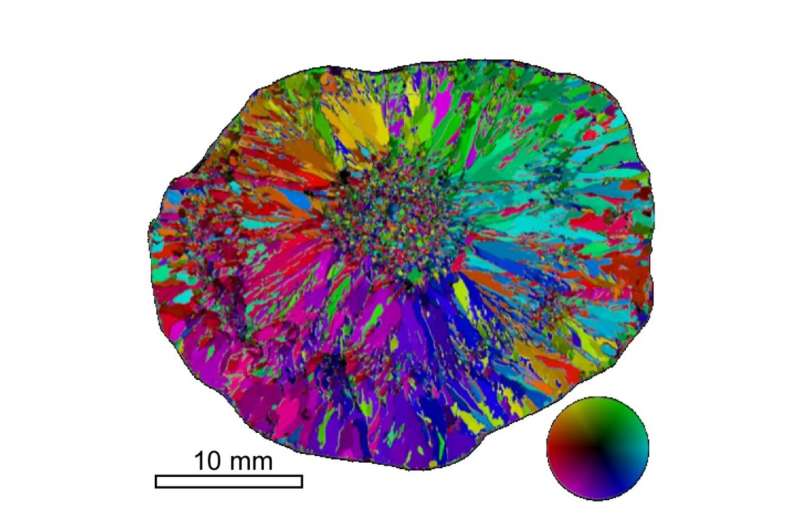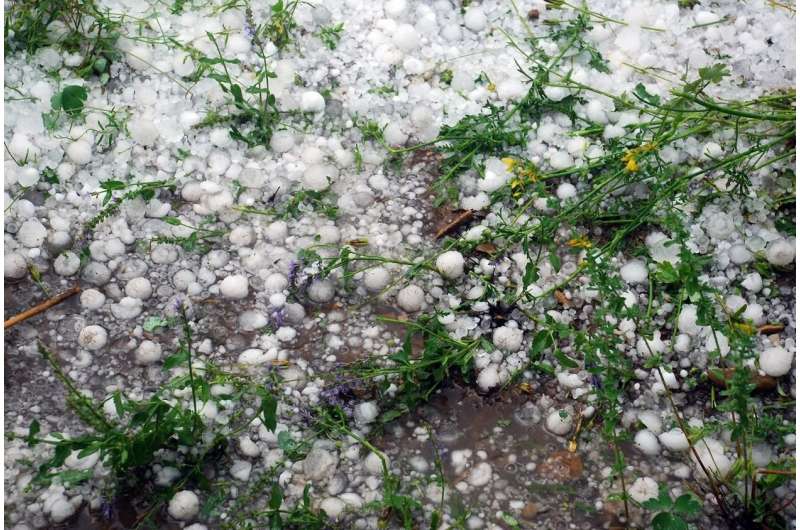Hailstone from the French Quarter in Tübingen - the automated ice texture analyzer shows the internal crystal structure. The colors show the orientation of the crystallographic lattice of each individual ice crystal and show that the hailstone underwent four growth stages. Credit: University of Tübingen
The Tübingen region has recently seen hailstorms that brought back memories of the devastating storm of 2013. At that time, billions of dollars in damage were caused, and the damage from the most recent storms is still being assessed. Despite all the trouble hailstones cause, they also possess a previously unknown inner beauty. In a recent study, Tübingen geoscientists Professor Paul Bons and Dr. Catherine Bauer made hailstones' crystal structure visible for the first time. They collected hailstones from the 2013 Tübingen storm and analyzed them in the laboratory. Not only did they come up with aesthetically pleasing images never seen before, they also provide insights into the structure and damage potential of hailstones. The results were recently published in the Journal of Glaciology.
Paul Bons and Catherine Bauer both conduct research into ice in places such as Greenland. They stored hailstones from the 2013 Tübingen storm at minus 32 degrees. "Ice samples should always be stored below minus 28 degrees, otherwise the internal structure can change within weeks," Bons explains.
For the study, he collaborated with glaciologist Dr. Maurine Montagnat from the University of Grenoble, France. Montagnat's team sectioned the hailstones from Tübingen together with others from southwestern France and used an "automated ice texture analyzer" to make images of the stones' internal texture.
The resulting images show the structure of the crystals in the hailstone in different colors, and reveal fascinating patterns and a beauty that is normally hidden from the eye. Each hailstone has its own individual structure.
Hailstones are formed from raindrops that are transported by updrafts in thunderclouds to altitudes of 12,000 meters and more, where they freeze. As they fall downward, they continue to grow—depending on temperature and humidity—as new layers of crystals freeze on. This procedure may be repeated several times. Updrafts carry the grains of ice up into the colder layers, and their weight causes them to fall back down. The more violent the thunderstorm, the higher the probability that large hailstones will end up hitting the ground.
The latest methods made it possible to study the growth stages and complex growth mechanisms of hailstones in much greater detail, Bons says. "This allows us to better understand how hailstones form and perhaps better predict what damage they can do."
Destructive on the outside, beautiful on the inside: Hailstones in Tübingen on June 23, 2021. Credit: University of Tübingen
More information: Maurine Montagnat et al, Texture characterization of some large hailstones with an automated technique, Journal of Glaciology (2021). DOI: 10.1017/jog.2021.66
Journal information: Journal of Glaciology
Provided by University of Tübingen

























